3 Qualitative project: Data collection and Processing (Group)
3.1 Preparation for collecting data
3.1.1 Planning the focus group
We suggest scheduling your focus group for Week 8.
Two people should run the focus group - one person should act as the facilitator and the other person should act as the note-taker. This is the minimum required to run the focus group.
If other members of your group would like to come along to watch, this is okay (but please ask your participants if they are comfortable with this). If additional members do join to observe, they should not participate in the group, and should have their microphones and camera's turned off so as not to interfere with the process.
We anticipate focus groups will be around 30-45 minutes (not including ice-breaker and setting things up at the start) - yours may be shorter or longer than this, but please discuss with your participants if you are planning a longer focus group, and ask them if they'd be comfortable with extending it.
Ethics information and the finalised version of the focus group schedule (just the main questions, not the probes/prompts) must be sent to your focus group members in advance, and they must return signed consent forms to you. Keep these safe - they do not need to be passed on to the Course Leads.
Please use the checklist and allocation activities that were given to you to complete in the Week 5 lab.
3.1.2 Ethics
Please adapt the Information Sheet and Consent form for your focus group. These do not need to be submitted for formative assessment. There are only a few, minor, sections in each form that need adapted in order to make them specific for your project.
You must give everyone participating in the group the Information sheet and consent form before the focus group takes place. Completed consent forms should be returned to the group hosting the focus group before the group commences. These must be destroyed after hand-in of the project.
Plan what the best approach for this will be among your group, and agree who will be responsible for this.
Remember that everyone (both those participating and running) the focus group have a responsibility to maintain confidentiality of the discussion.
3.1.3 Collecting demographics
It might be a good idea to collect demographics information - discuss with your group what might be best to collect. Remember to only collect what you need to help the reader understand the context of your focus group. Demographics information must be collected using Microsoft Forms.
Sign into Microsoft forms and click new quiz
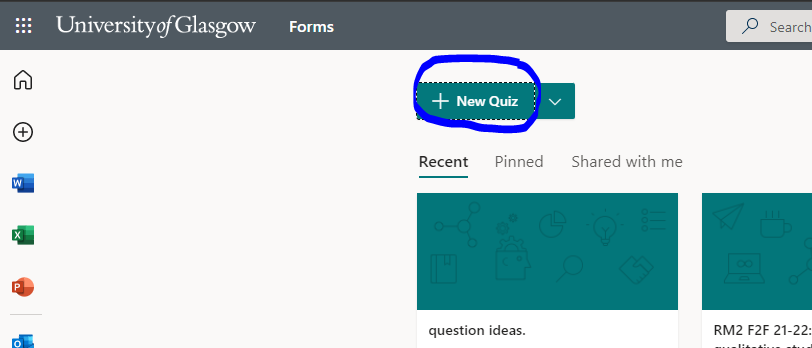
Figure 3.1: How to make a new quiz
Then click add new question and you will be able to select the type of question. There are a number of options; it's most likely that choice (multiple choice) or text (open textbox) will be what you will use.
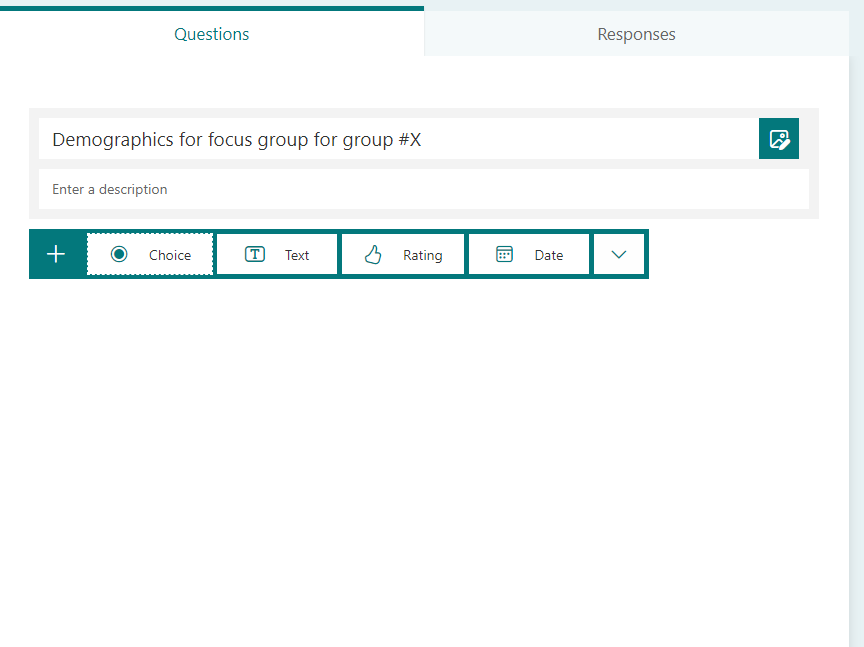
Figure 3.2: Adding questions
Your first question should ask for the identifier. When you give the participants the consent form, there should be a number that you assign to them. This helps you link up the person and the demographics but without asking them to provide their name.
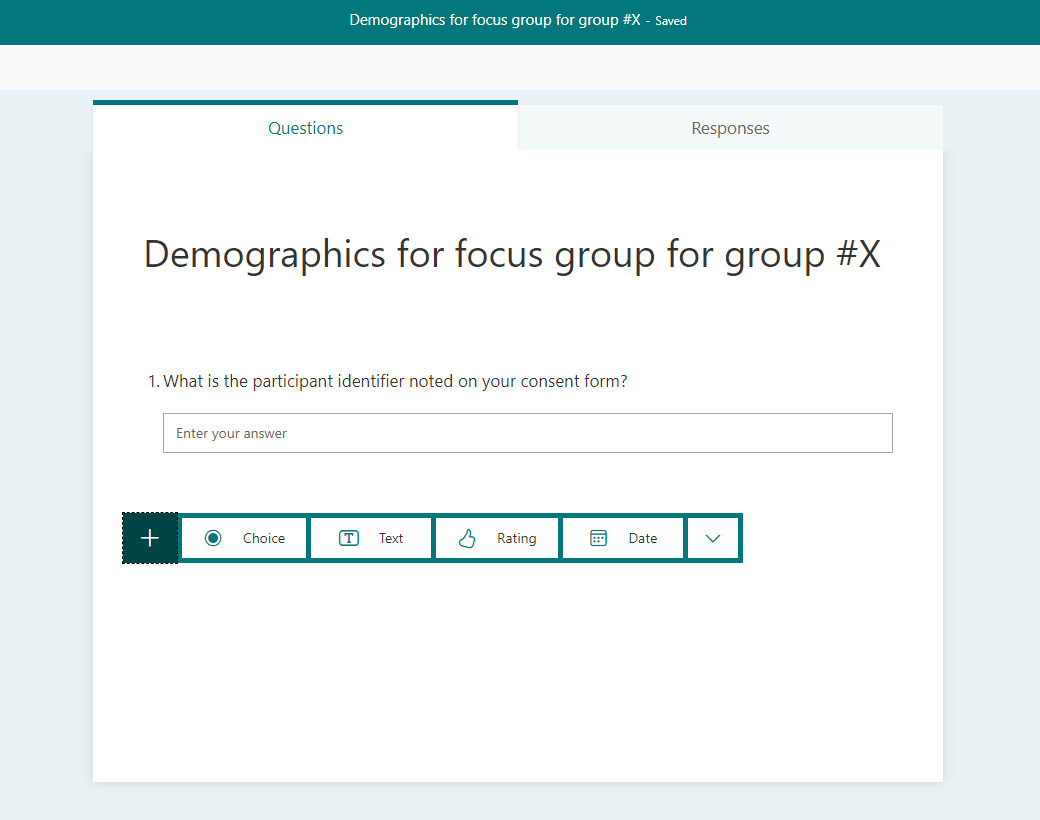
Figure 3.3: Linking demographics
From here, you can add in the agreed questions from your group.
There are a few things to note:
Please do not collect names automatically - this can be turned off by going to the three dots to the right of Share (at the top right), then Settings, then untick ‘record name’ You will see your responses come in via the ‘responses’ tab. These can be downloaded in excel format To share, click share and then you can copy a link that you can send out to your participants.
3.1.4 Focus group structure
There are a number of stages to a focus group, and it's not always exactly the same, but we would advise the following structure for your focus group:
Stage 1: Setting the scene. The topic of the project should be introduced by the facilitator, and everyone agrees to take part. It must be made clear to the people in your focus group a) that they do not have to answer any questions that they do not feel comfortable with, b) highlight that the session will be recorded, and they have a choice to have their camera on or off, but that the mic must be used, c) what will happen with the recordings (i.e. that they will be kept safe on University-approved servers and the transcript anonymised), d) that everyone has a responsibility to maintain confidentiality of the topics discussed in the group and e) that they are free to leave the session at any time. Run through the Information Sheet and Consent Form here, and discuss any ground rules you have. I would also raise the point here that there are a few questions to get through, and therefore you might have to step in to help manage time.
Stage 2: Recording. Remember to press record!! This is very important.
Stage 3: Introductions. Go around the 'table' and ask everyone to introduce themselves. Start with yourself and the note-taker first. Everyone should state their first name clearly.
Stage 4: Ice-breaker. Ask a warm-up question or ice-breaker. The aim is to allow participants to introduce themselves, ensure everyone understands the procedure, and to encourage people to feel comfortable talking. Previous projects have used photos, cartoons, and media, or asked participants to generate meanings of the terms used in the discussion (e.g., “poor sleep”,”well-being”) to get people talking.
Stage 5: Discussion. This is where you ask your main questions, and follow-up questions. It is a good idea to prepare around five or six main questions, and perhaps highlight three or four that are most important to focus on. The discussion may follow a different order to that on the focus group schedule - this is fine.
Stage 6: Facilitating the discussion. The facilitator should be prepared to help steer conversation back on track, and balance discussion so that everyone gets a chance to contribute. Have a few specific prompts that relate to each question and/or some general prompts to keep the discussion flowing. What are you going to do if no-one participates? Or if one person is contributing? For example… “has anyone else had a similar experience? ..Does anyone have a different view?” At the same time be ethical and avoid targeting people. Give participants the opportunity to describe their interpretations and take ownership. E.g., “How would…make you feel”, “Have you ever noticed that…” “Think back to when…”, “What was most important to you about…?”
Stage 7: Ending the discussion. It's good to end the discussion by going round the group and asking each participant if they have anything they want to add to the discussion/sum up their thoughts on what was discussed.Remember to allow focus group members the chance to confirm/withdraw consent for their anonymised contributions to be used. Also remind them that the discussion cannot be reproduced/recorded for any other purpose than for the qualitative report.
Please discuss some 'ground rules' at the start with the group, and also go through the Information Sheet and consent form at the start, to ensure everyone is aware of their responsibilities.
3.1.5 Facilitation and note-taking
3.1.5.1 Facilitation/moderation
The facilitator (sometimes also known as the moderator) will be the person taking the lead during the focus group. They will be the one asking the questions of the participants, and the one facilitating the discussion. As you are aiming to mimic a naturalistic conversation, you have to build rapport. Ensure you allow everyone time to introduce themselves, and contribute to the ice-breaking phase by saying a bit about yourself.
A good interviewer shares the perspective of the people they are talking to throughout the focus group. The interviewer should not be listening out for good quotes and should not be thinking about what to analyse. The role of the interviewer is to listen to the participants, and understand their points of view.
3.1.5.2 Note-taking
It is a good idea to have a note-taker there. Hopefully there will be no IT issues that mean that the recording doesn't work! Therefore, the note-taker should remind the facilitator about recording if required, and note down any impressions/initial thoughts around themes/good quotes. This can be helpful when you come to analysis. Was anything unexpected? Did participants focus on a particular aspect of a question over others? Was there anything that the discussion kept coming back to? Also, you could note down how well the questions worked - were there any that participants didn't understand?
3.1.5.3 Facilitation: how to manage the group
There is likely to be variety in the class in terms of how to manage group dynamics in your focus group. Here, we have some tips for those who might find them useful.
Balance contributions from those who are quieter and those who are more dominant in a group situation
- The ice-breaker/easy opening questions are perhaps most important for quieter members of the group, to help make them feel more comfortable.
- It might be a good idea to use the 'Raise hand' feature on Teams - this would allow quieter members to show that they want to contribute, but without trying to gauge when to jump in the conversation. You can then take points in order of when they raised their hands.
- If some people have contributed to part of the discussion and others haven't, open it up to the rest by asking if anyone who hasn't responded yet has anything to add. However, don't put people on the spot by asking them directly.
If the discussion is stuck on one topic
- Remind the members of the group that there are a number of different questions to explore, and that you are mindful of time, so it might be best to leave that topic for now, and you can return if there's time at the end.
If you are unsure what someone meant
- Seek clarity during the focus group if you are unsure about what a participant meant during the discussion.
3.1.6 Practical considerations
You don’t have much control of the environment, as we are all doing our focus groups online using Microsoft Teams. It is not possible to do them in person due to logistical restraints (recording equipment and booking space) and you cannot use platforms other than Microsoft Teams due to logistics (Zoom is limited to 40 mins) as well as University requirements around GDPR.
You will be recording the visual and audio content of this focus group. Practice using the Teams environment with the rest of your group in advance. See this video for help.
Please press record before you start the focus group! You do not want to end the focus group and find out that you didn’t press the right button and the whole thing is gone. Just in case, a member of the group could be taking notes. This should never be the interviewer, as this would distract them from their task of understanding what is being said.
After the focus group, consider the following questions:
- Do you think your research question has been answered? If not, why not?
- If participants went off-track, is that because there was a flaw in your questions, or because they hit on a topic that was more interesting to them?
Either way, you can write up a really strong project by being reflexive and considering what you could do differently in future.
3.1.6.1 Setting up and recording the online focus group
- Pilot the focus group schedule on friends first
- Are there any questions that need refined?
- Do a test recording beforehand using Microsoft Teams and Microsoft Stream (transcription software). This should be done early enough that you can contact one of the Course Leads if there are any issues.
- See the 15 minute video here for how to set up and record a Teams meeting and access the transcript.
- Did everything work okay in the test? Is there anything you are uncertain of? If there were any issues during the test (e.g. if you weren't able to access Stream), contact the Course Leads ASAP and let them know.
3.1.6.2 Downloading the transcript
You can access the transcript on the teams chat that has been set up automatically when you record. Stream. You can either download it as a word doc or vtt text file.
Method 1: Go to the chat for your recording and then select the three dots next to 'transcript'. You can choose to download the transcript either as a word doc or a vtt. We recommend the word doc if it's available, but if not then the vtt will be fine.
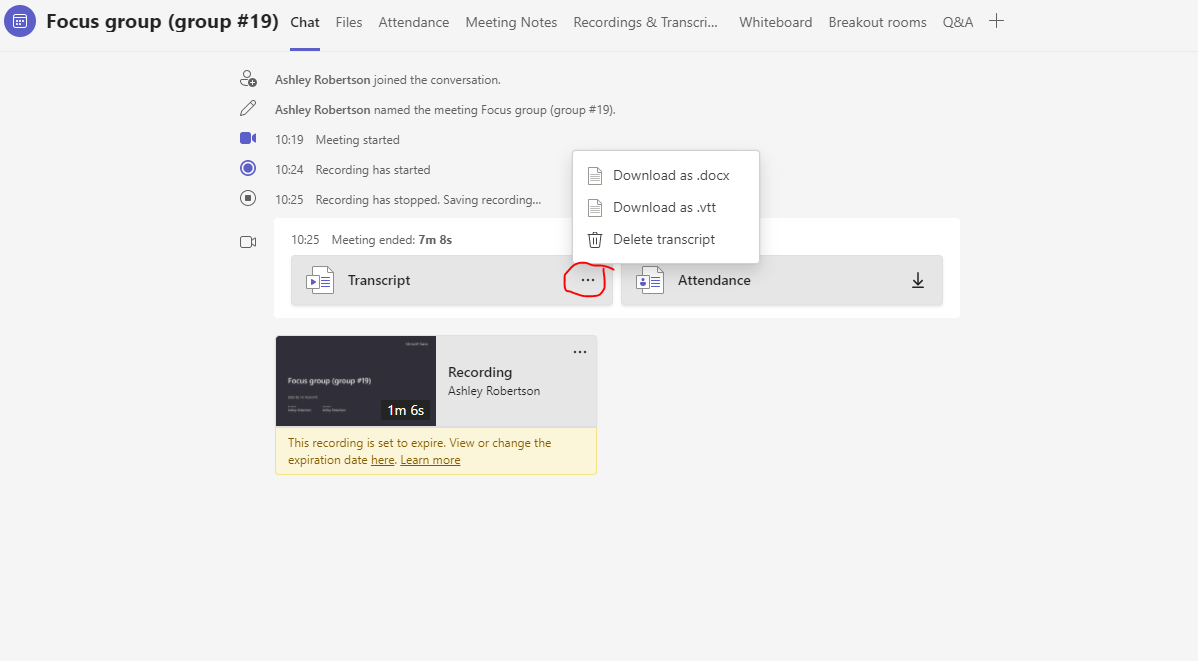
Figure 3.4: Downloading the data method 1
Method 2: Click the link for the video in the chat. It might only be the person who recorded it who has access automatically, or it might be everyone in the chat. Click on 'Transcription'. Please note that it will only be the .vtt file you get using this method.
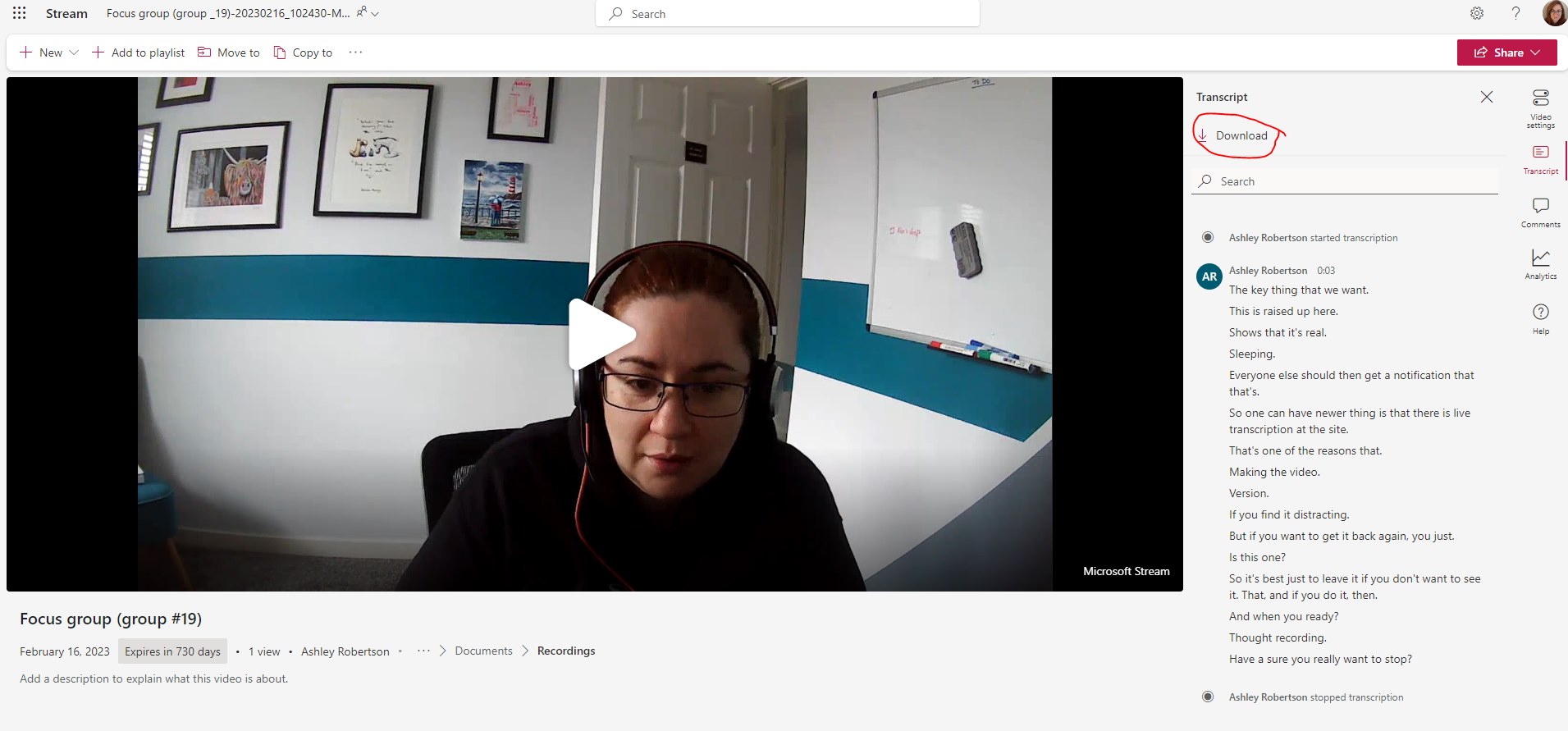
Figure 3.5: Downloading the data method 2
Method 3: If you log onto Stream directly, you can access all recordings - click on the relevant one and then follow the steps above (in Method 2) to access the transcript
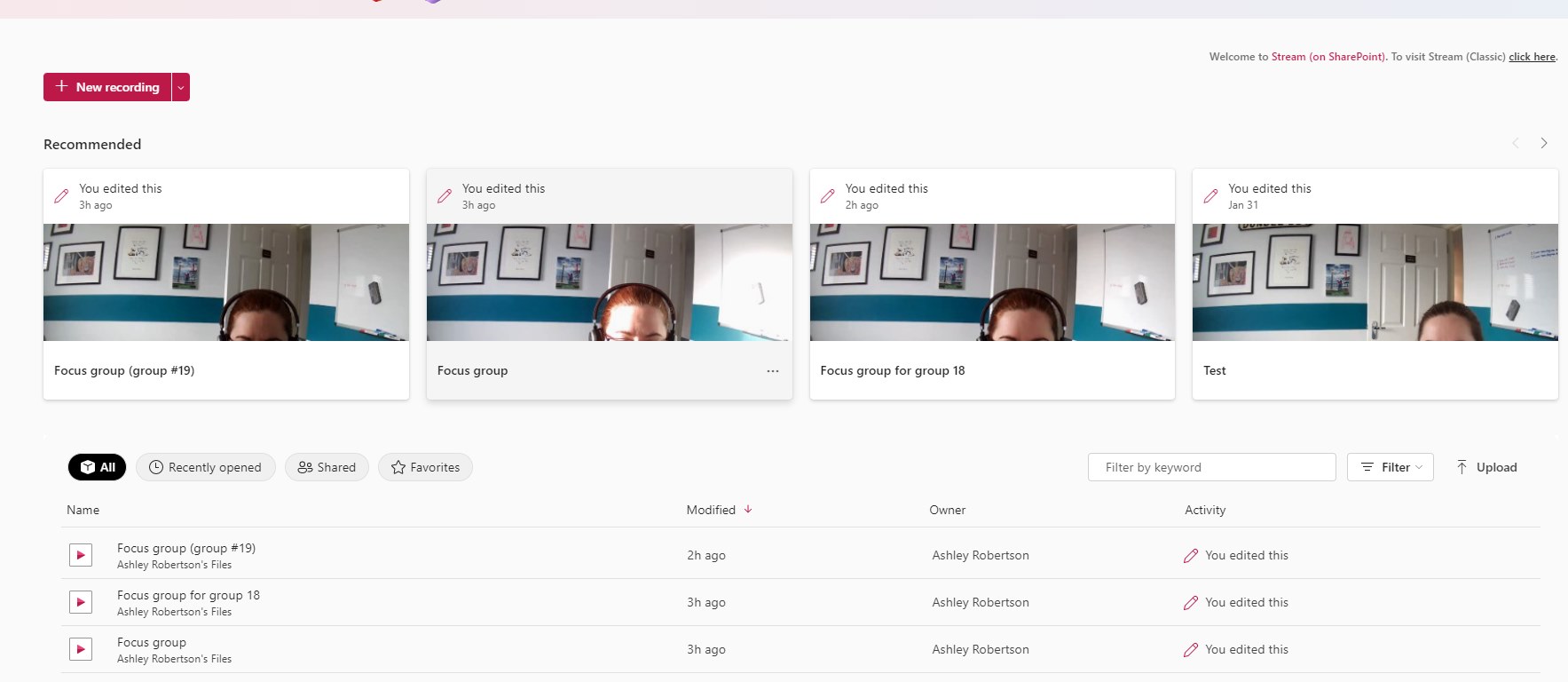
Figure 3.6: Downloading the data method 3
3.1.6.3 GDPR compliance
GDPR: general data protection regulation. It is the most up to date data protection law.
For your project it is important that:
- Data will be retained until after completion of the project on a password-protected encrypted drive and a secure database accessible only to the research team.
- After this period (end of academic year 2020-21), any paper documents will be shredded and disposed and electronic files will be deleted.
Storing and Accessing Data Securely
- Make a copy of the recording from Stream onto a secure file sharing network (i.e. One Drive via Office 365).
- Delete the recording from Stream as soon as you have done this (double-/triple-check you have saved the recording properly beforehand!).
- Make sure that you only share the anonymised transcript with the group via One Drive.
- Do not share via social media, Google Drive or personal email which is not secure.
- See the University guidelines on handling confidential data
3.1.7 Processing data: Transcribing
Transcribing is where you take an audio recording and make a version of this that is written down. This is then what we use as our data when we analyse qualitative research (on the whole, anyway!).
3.1.7.1 Overview of transcribing for your project
For your RM2 project, you will be recording your groups online. This means that it should be possible to use the auto-generated transcript. The auto-generated transcript normally take a little while longer to generate than the recording - it is normal for it to take up to 24h to arrive. If you use the auto-generated transcript, then it should be relatively easy to obtain a transcript for the whole focus group.
If the auto-generated transcript does not work for any reason, then it is fine to just transcribe a 10 minute portion of the focus group from the recording by hand. Ideally, this should be a whole 10 mins (e.g. not 2 mins at the start, 5 in the middle and 3 at the end).
Please see the steps outlined in 'Setting up and recording the online focus group' (part of 'Practical considerations' for information about how to download your transcript.
This section will instead contain details of how you should move the content over from the autogenerated text file to the transcript, and what we'd typically expect to see.
3.1.7.2 Transcribing and editing your transcript
Here is an example of a template that you might find useful. You are not required to use this, but you are welcome to do so.You will have to download your own copy as you will not be able to edit the original.
At the top, complete the details of all those who attended the focus group. We'll anonymise later, as it's easier to do this all at once rather than as we go along.
It's advisable to have a time stamp regularly (I normally do one per minute), so that I can easily find the right part in the original recording if I have to. However, if you do not want to put this in, you do not need to. There are line numbers in the template - it is good practice to include these, but it can be time-consuming to do so. If you would prefer to remove the line number column, this is okay.
With each new speaker, take a new line in the table. You will need to add more lines to the table - do this by inserting rows at the bottom. Only move to a new cell with each new speaker.
The next step is to go through the transcript and compare it to the recording. Are there any parts that the auto-gen transcript that are incorrect? Replace these in the transcript with what should be the case.
3.1.8 Processing data: Pseudonymisation
Step 1: Decide in your groups what data needs to be removed or replaced in order to ensure the participants are not identifiable. Some examples:
- Speaker names?
- Names mentioned within the transcript?
- Locations?
- Job titles?
- Unusual situations (e.g. I had a participant who had an experience that they spoke about and had been in the newspapers...we had to change the details of this to ensure it was anonymous).
Step 2: Are you going to remove the information completely or replace it?
If we had a transcript with the following information:
"So, yeah, John and I went to uni together in Leeds, and we met up with Sandy for the first time there. All three of us went a trip to Broughty Ferry."
Option 1: We have the option of replacing:
"So, yeah, Mike and I went to uni together in Manchester, and we met up with Karen for the first time there. All three of us went a trip to Montrose."
If you replace, keep it consistent throughout the transcript (e.g. every time John is mentioned, it should be replaced with Mike; each time Leeds is mentioned, it should be replaced with Manchester).
The easiest thing to do is have a key (this is just a document where you have noted what all the replacements are) - in this, just state what you are using for each unique replacement. Once you've replaced everything that needs replaced, you can delete the key.
You should have a clear rationale for what you are replacing, and should be upfront with the reader in your methods section if you choose this.
Option 2: We have the option of redacting:
"So, yeah, (brother) and I went to uni together in (city in England), and we met up with (friend) for the first time there. All three of us went a trip to (small town in Scotland)."
You should always replace the speaker names (i.e. denoting who is speaking in the transcript), but you can redact the actual words spoken if you choose.
Step 3: Discuss in your group, and arrange which approach you want to take. Decide who is going to anonymise the transcript.
3.2 Collecting data: questions
For this qualitative project, we have a bank of questions from previous students on the different topics for you to use. You can change the questions you choose slightly to fit the exact research question that you are asking.
If you are doing a topic where the questions don't quite fit, this is okay, but you will need to run all questions past your tutor in their office hours. You should also make sure that you develop any questions using the guidance in the section below as well as in Lab 4
The list of questions is available as a word document, as well as listed below.
3.2.1 Question bank
3.2.1.1 Green Spaces
- What green spaces on the university campus do you use? If you don't use any green spaces, why not?
- How does spending time in green spaces affect your stress levels?
- Can you think of a time where being in a green space influenced your mood?
- How does spending time in green spaces affect other aspects of your life?
- How do you feel students benefit from green spaces on campus?
- Can you think of a way the weather/environment could impact this?
- What would make you use green spaces more?
- What do you believe the university could do to improve the benefits of green spaces on campus?
- How do you tend to feel before going on walks?
- Thinking back to a recent walk, what changes (if any) did you notice in your mood?
- In what ways was the outcome of the walk different to what you expected beforehand?
- Have you previously used time outdoors as a way to relieve stress? If so, please elaborate.
- Do you think that going outside to relieve stress would always be effective? If so, please tell me why you think this.
- Do you think you will incorporate walks or time in green space more into your routine? Why or why not?
- With the existing green spaces that there are, is there anything you would want to change to make them maybe more attractive for using them?
- what are your motivations are for engaging with green spaces?
- Do you think that having grown up in a specific environment has shaped how you seek out green spaces when you're in a city?
- Are there any specific barriers that you have in your own life when it comes to engaging with green space, whether that's like green spaces in Glasgow or green spaces outside of Glasgow?
- How does seeing images of nature on social media make you feel?
- Can you think of a situation where social media encouraged you to go into nature?
- when you spend time in nature, do you find yourself using social media or thinking about using social media?
- Are there any specific aspects of nature (e.g. plants, scenery) that you find helpful for your mental well-being?
- Do you spend time in nature? - and how can you describe your general experiences with spending time in nature?
- How do you feel after spending time in nature?
- Do you purposely use nature to improve your mental well-being and if so, in what ways?
- Can you describe a specific instance when you felt stressed or overwhelmed and how you used nature as a mechanism to recuperate your mental well-being?
- Considering the context of time (short and long term), how has the experience of using nature as a mechanism of recuperation impacted your overall mental well-being?
- Do you have any green spaces that are kind of prominent in your daily life?
- How would you say you cope with stress with uni work or just general stresses in life?
- How do you perceive spending time in green spaces to impact your stress levels?
- Would you say green spaces around campus or around your area, affect any other aspects of your life? If so, how? If not, why not?
- If you were to picture an ideal green space you could use within the campus, what would that look like?
- How do you feel that the weather might have an impact on you wanting to use green spaces?
- How do you feel students might benefit from green spaces on campus?
- what do you believe the university could do to improve the benefits of green spaces on campus?
- when you're feeling really stressed what kind of things would you try and do to make yourself feel better?
3.2.1.2 Mental Health and Wellbeing
- What does mental wellbeing mean to you?
- How would you define wellbeing?
- What does good mental health look like to you?
- What does stress mean to you?
- What do you think causes stress in postgraduate students?
- Which factors do you think affect students’ experiences of stress?
- How do you think stress affects (postgraduate) students?
- Can you describe what has contributed to your psychological wellbeing during postgraduate study?
- Has your psychological wellbeing changed between your undergraduate and postgraduate degree? If so, how? If not, why do you think not?
- How do you think doing a postgraduate course might affect students’ mental health and wellbeing?
- How might doing a conversion course in particular impact on students help-seeking behaviours?
- How do you perceive the mental health and well-being status of conversion course postgraduates?
- What are some of the factors you think influence student mental health? Think about both positive and negative influences.
- Do you believe that your university course has had an effect on your wellbeing? If so, how has it affected you? If not, why not?
- What are some of the mental health challenges you think students might face?
- What do you do to take care of your mental health?
- What do you think students do to manage their mental health?
- What would you consider to be mental health management strategies?
- Why do you think some mental health management strategies work well while others do not?
- What makes an effective coping mechanism?
- What would you do if a peer came to you with their mental health issue?
- What advice would you give for students to maintain good mental health during their studies? What would you say to avoid in order to maintain good mental health?
- What do you think comprises a good or robust mental health service?
- How do you think universities could improve mental health services for students?
- Can you describe the mental health services at your institution?
- Why do you think mental health services offered by universities are important?
- What can be done to encourage people to seek help when they need it?
- Why do you think students may not engage with the university mental health support available to them?
- What do you think might prevent postgraduate students from seeking help for mental health?
- What do you think makes students engage with university wellbeing and mental health services?
- Do you feel that the university is providing appropriate resources and assistance to help you manage your wellbeing during your studies? If yes, how are they doing that? If not, why not?
3.2.1.3 Belonging
- What does belonging mean to you?
- What does a sense of belonging at the University mean to you?
- How do you understand a sense of belonging?
- Why do you think a sense of belonging at university is important? If you don’t think it’s important, why not?
- Have you actively tried to improve your sense of belonging at the university? If yes, how? If not, why not?
- What motivates you to develop a sense of belonging at the university?
- How does the social aspect of being a student at university affect your sense of belonging?
- Can you tell me about any non-academic activities you’ve participated in [while studying the postgraduate conversion course], and whether it affected your sense of belonging within your course/university?
- What aspects of the academic side of university (for example, the way courses are structured, course content, group work etc.) help you to feel like you belong?
- What physical aspects of university do you think help facilitate or prevent a sense of belonging in students (for example: study spaces, library, travelling to university, halls etc)?
- Are there specific places where you feel a sense of belonging within the university environment? (for example, in a certain class, building, extra-curricular activity etc.). If yes, what is it about these places that makes you feel like you belong? If not, why not?
- What do you think makes students feel like they belong at university?
- What things do you think may prevent students feeling a sense of belonging at university?
- What has helped you feel like you belong at university?
- Could you tell us about a time when you felt a sense of belonging at the university?
- Could you tell us about a time when you felt disconnected from the university? What made you feel that way?
- How has your sense of belonging at university changed from doing and undergraduate degree to doing a postgraduate degree? If it hasn’t changed, why do you think not?
- Did you find it easier/harder to develop a sense of belonging as an undergraduate student? If so, why? If not, why not?
- How do you think sense of belonging might affect students’ university experience?
- How can universities improve a sense of belonging for students?
- Can you give us any examples of the impact that you think belonging can have on a person’s wellbeing?
3.3 How to structure your focus group schedule
Preparation is essential for the focus group process to run smoothly. This includes taking the time to think about and try out your focus group schedule.
At this stage we are looking for an example of an icebreaker, and the main questions you want to ask your participants (with prompts/probes, if appropriate). You should also have an exit/wrap up question. - Prompts are additional questions to remind your participants of the key points – you would only need to use these if they don’t answer part of the question in their answer. - Probes are supplementary questions that you can ask to get more information: e.g. to clarify or justify something, or to give an example.
You should choose around five to six main questions for your focus group from the question bank. If you need to alter these slightly so that they make sense, this is fine. However, if you modify them significantly or you make up new questions, you must go to your tutor’s office hours to discuss your questions with them before you use them in your focus group.
3.3.1 Warm up Question
Start off with a warm up question. The aim is to allow participants to introduce themselves, ensure everyone understands the procedure, and to encourage people to feel comfortable talking. Previous projects have used photos, cartoons, and media, or asked participants to generate meanings of the terms used in the discussion (e.g., “poor sleep”,”well-being”) to get people talking. In other focus groups, students have asked people to describe the place they would most like to visit or what their favourite meal from their home country is. It should be a question that generates discussion and is something that is easy to answer.
3.3.2 Main Focus Group Questions
Choose 5-6 questions on your topic from the list in the question bank. You may need to modify these slightly to get them to work for your topic. Remember that, if you need to make a new question up, you can do so. However, you will need to run it past your tutor to make sure it is appropriate.
Bear in mind that you may not cover all aspects of your research question in one focus group - the discussion may wander off track or focus on one aspect. Consider which part of the research question you think is most important to get people to answer. Start with this and be prepared to come back to it at the end if you need to. If you have more sensitive questions in your research schedule, they should be included later on, so people answer them when they are more comfortable.
Some tips for developing questions: - Avoid asking questions that ask two or three things in one sentence (e.g., about behaviour and impact on mood). Break it down into simpler questions. - Try to avoid asking questions that can be answered yes/no, unless you then follow up with a question opening things up. Although yes/no questions are useful for gathering information, they are not helpful for generating a discussion. Your questions should be open. - Add in probes/prompts to elicit further information if required. - Remember to ask people about their perspectives/perceptions/experiences/opinions/views
3.3.3 Closing question
The aim here is to give people an opportunity to add anything that might have been missed in the discussion/to wrap things up. Examples might be ‘Does anyone have anything else that they would like to add before we finish the focus group?’ or ‘Thank you for your participation – is there anything that anyone would like to add before we wrap things up?’